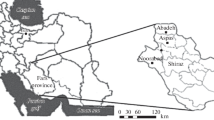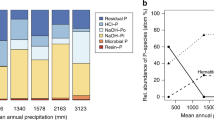Abstract
The quantities of phosphorus leached or carried away by erosion are always low in comparison with the quantity of P taken by plants. Therefore, without P application, dynamics of P in soil-plant systems depends mainly on plant P uptake from available soil P. This paper concerns mainly the description and the analysis of available soil phosphate. Available soil P is generally determined using extraction methods. It was shown, using isotopic exchange, method developed in soil-solution mixtures in steady-state, that available soil P could be described as a system with many pools. For agronomic purposes, available soil P was described with five pools of phosphate ions which have increasing rates of transfer from soil particles to soil solution. The most important is a pool which contains only directly available phosphate ions. These phosphate ions leave the solid phase of the soil to enter in the soil solution in a time shorter than 15 seconds: this time is the minimum time required to realize its determination. The intensity, quantity and capacity factors recommended to describe the available soil P are derived from experimental data characterizing this pool. The four other pools all are directly branched on this central pool. They are characterized by the quantities of P they contain and by the time required for the phosphate ions they contain to enter into the soil-solution. Effects of continuous P uptakes and of various P applications on these compartments were described. It was shown that: (i) continuous cropping without P return decreases ineluctably the intensity and quantity factors, and consequently soil P fertility (ii) applications of P quantities higher than P outputs with crops do not always increase the intensity and quantity factors, and consequently available soil P and its availability. The absolute values of the increase depends on: the type of P fertilizer or crop residues applied on the soil, on the level of soil P fertility before P application and on the fixing capacity of the soil for phosphate ions.
Similar content being viewed by others
References
Aslyng HC (1964) Phosphate potential and phosphate status of soils. Acta Agric Scand 14: 261–285
Barber SA (1984) Soil nutrient bioavailability: a mechanistic approach. Wiley Interscience, John Wiley & Sons, New York, USA
Barrow NJ (1980) Evaluation and utilization of residual phosphorus in soils. In: Khasawneh FE, Sample EC & Kamprath EJ (eds) The Role of Phosphorus in Agriculture pp, 333–361. American Society of Agronomy, Madison, Wisc, USA
Barrow NJ (1991) Testing a mechanistic model. XI. The effects of time and of level of application on isotopically exchangeable phosphate. J Soil Sci 42: 277–288
Barrow NJ & Shaw TC 1975 The slow reaction between soil and anions: 3. The effect of time and temperature on the decrease in isotopically exchangeable phosphate. Soil Sci 119: 190–197
Blair GJ, Till AR & Smith RCG (1977) The phosphorus cycle. What are the sensitive aeras? In: Blair GJ (ed) Prospects for improving the efficiency of phosphorus Utilization. Rev Rural Sci 3: 9–19
Bolland MDA (1992) The phosphorus requirement of different crop species compared with wheat on lateritic soils. Fert Res 32: 27–36
Bolland MDA & Gilkes RK (1992) Evaluation of the Bray 1, calcium acetate lactate (CAL), Truog and Colwell soil tests as predictors of triticale grain production on soil fertilized with superphosphate and rock phosphate. Fert Res 31: 363–372
Boniface R & Trocmé S (1988) Enseignements fournis par des essais de longue durée sur la fumure phosphatée et potassique. 2. Essais sur la fumure phosphatée. In: Gachon L (ed) Phosphore et Potassium dans les relation sol-plante: conséquences sur la fertilisation. pp 279–402. INRA, Paris, France
Dalal RC & Hallsworth EG (1977) Measurment of isotopic exchangeable soil phosphorus and inter-relationship among quantity, intensity and capacity factors. Soil Sci Soc Am J 41: 81–86
Dean LA Nelson WL Mackenzie AJ, Armiger WH & Hill WL (1947) Application of radioactive tracer technique to studies of phosphatic fertilizer utilization by crops: Greenhouse experiments. Soil Sci Soc Am Proc 12: 107–112
Fardeau JC (1992) La fertilité des sols et son entretien. In: Brun Bellut J & Morel JL (eds) Agriculture, Environnement, Qualité. pp 51–73. ENSAIA-INPL, Nancy, France
Fardeau JC (1993) Le phosphore assimilable des sols: sa représentation par un modéle fonctionnel á plusieurs compartiments. Agronomie 13: 317–331
Fardeau JC & Frossard E (1992) Processus de transformations du phosphore dans les sols de I'Afrique de I'Ouest semi-aride: application au phosphore assimilable. In: Tiessen H & Frossard E (eds) Phosphorus Cycles in terrestrial and aquatic Ecosystems. Regional workshop 4: Africa, pp 108–128. Saskatoon University, Saskatoon, Canada
Fardeau JC & Jappé J (1976) Nouvelle méthode de détermination du phosphore assimilable par les plantes. CR Acad Sci Paris, Série D 282: 1137–1140
Fardeau JC, Chabouis C & Hétier JM (197T) Méthodes des cinétiques de dilution isotopique des ions PO4 et K+: applicationá l'analyse des modifications defertilité des essaisde trés longue durée. Bull Assoc Fr Etude Sol 2: 111–122
Fardeau JC, Morel C & Boniface R (1988) Pourquoi choisir la méthode Olsen pour estimer le phosphore “assimilable” des sols. Agronomie 8: 577–584
Fardeau JC, Morel C & Boniface R (1991) Cinétiques de transfert des ions phosphates du sol vers la solution du sol. Agronomie 11: 787–797
Fardeau JC, Morel C & Oberson A (1993) Phosphore, matiére organiqueset eutrophisation des écosystémes. In: Decroux J & Ignazi JC (eds) Matiéres Organiques et Agricultures, pp 125–138. NDT, Blois, France
Fardeau JC, Poss R & Saragoni H 1992 Effect of potassium fertilization on K-cycling in different agrosystems. In: Potassium in Ecosystems, pp 59–78. International Potash Institute, Basel, Switzerland
Feller CW 1966 An Introduction to Probability Theory and its Application, Vol II. John Wiley & Sons, New York, USA
Frissel MJ (1978) Cycling of Mineral Nutrients in Agricultural Ecosystems. Elsevier, Amsterdam, the Netherlands
Frossard E, Brossard M, Hedley MJ & Metherell A (1995) Reactions controlling the cycling of P in soils. In: Tiessen H (ed) Phosphorus in global Environment, pp 107–137. John Wiley & Sons Ltd, New York, USA
Frossard E, Fardeau JC Brossard M & Morel JL (1994) Soil isotopically exchangeable phosphorus: a comparison between E and L values. Soil Sci Soc Am J 58: 846–851
Frossard E, Fardeau JC, Ognalaga M & Morel JL (1992a) Influences of agricultural practice, soil properties and parent material on the phosphate bufering capacity of cultivated soils developed under a temperate climate. Eur J Agron 1: 45–50
Frossard E, Feller JC, Tiessen H, Stewart JWB, Fardeau JC & Morel JL (1992b) Can an isotopic method allow for the determination of phosphate fixing capacity of soils? Commun Soil Sci Plant Anal 24: 267–377
Gianinazzi-Pearson V, Fardeau JC, Asimi S & Gianinazzi S (1981) Source af additional phosphorus adsorbed from soil by vesiculararbuscular mycorrhizal soybeans. Physiol Vég 19: 33–43
Khasawneh FE & Doll EC (1978) The use of phosphate rock for direct application to soils. Adv Agron 30: 159–206
Larsen S (1952) The use of32P in studies on the uptake of phosphorus by plants. Plant Soil 4: 1–10
Lubchenco J & 16al. (1991) The sustainable biosphere initiative: an ecological research agenda. Ecology 72: 371–412
Morel C (1988) Analyse, par traçage isotopique, du comportement du phosphore dans les systémes sol-engrais-plantes: conséquence en matiére de fertilisation. Thése, Université Aix-Marseille III, France
Morel C & Fardeau JC (1987) Le phosphore assimilable des sols intertropicaux: ses relations avec le phosphore extrait par deux méthodes chimiques. Agron Trop 42: 248–256
Morel C & Fardeau JC (1988) Détermination par traçage isotopique de la valeur fertilisante du phosphate alumino-calcique: comparaison avec d'autres formes. Agronomie 8: 47–54
Morel C & Fardeau JC (1990) Uptake of phosphate from soils and fertilizers as affected by soil P availability and solubility of phosphorus fertilizers. Plant Soil 121: 217–224
Morel C & Plenchette C (1994) Is the isotopically exchangeable phosphate of a loamy soil the plant available P? Plant Soil 158: 287–297
Nirel PMV & Morel FMM (1990) Pitfalls of sequential extractions. Water Res 24: 1055–1056
Oberson A, Fardeau JC, Sticher H & Besson JM 1993 Soil phosphorus dynamics in cropping systems managed according to conventional and biological agricultural methods. Biol Fert Soils 16: 111–117
Poss R, Fardeau JC, Saragoni H & Quantin P (1991) Potassium release and fixation in ferrasols (oxisols) from Southern Togo. J Soil Sci 42: 649–660
Salcedo IH, Bertino F & Sampaio EVSB (1991) Reactivity of phosphorus in northeastern Brazilian soils assessed by isotopic dilution. Soil Sci Soc Am J 55: 140–145
Sharpley AN & Withers PJA (1994) The environmentally-sound management of agricultural phosphorus. Fert Res 39: 133–146
Sheppard CW (1972) Basic principles of the tracer method. Introduction to mathematical tracer kinetics. John Wiley & Sons, New York, USA
Stevenson FJ (1985) The phosphorus cycle. In: Stevenson FJ (ed) Cycles of Soil pp 231–284, John Wiley & Sons, New York, USA
Syers JK & Lu Ru-kun (1990) Inorganic reactions influencing phosphorus cycling in soils. In: Phosphorus Requirements for sustainable Agriculture in Asia and Oceania, pp 191–197. IRRI, Manilla, Phillipines
Thibaud MC, Morel C & Fardeau JC (1988) Contribution of phosphorus issued from crop residues to plant nutrition. Soil Sci Plant Nutr 34: 481–491
Walworth JL & Sumner ME (1987) The diagnosis and recommendation integrated system (DRIS). Adv Soil Sci 6: 149–188
White RE & Beckett PHT 1964 Studies on the phosphate potentials of soils. Part I. The measurement of phosphate potential. Plant Soil 20: 1–16.
Wiklander L (1950) Kinetics of phosphate exchange in soils. Ann R Vet Coll Sweden 17: 407–424
Author information
Authors and Affiliations
Additional information
This paper was originally submitted as part of the special issue on Evaluation of the Agronomic Effectiveness of Phosphate Fertilizers through the use of Nuclear Related Techniques edited by F. Zapata.
Rights and permissions
About this article
Cite this article
Fardeau, J.C. Dynamics of phosphate in soils. An isotopic outlook. Fertilizer Research 45, 91–100 (1995). https://doi.org/10.1007/BF00790658
Received:
Accepted:
Issue Date:
DOI: https://doi.org/10.1007/BF00790658




